Introduction
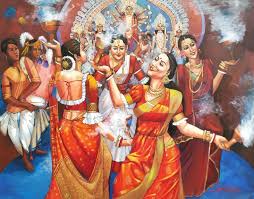
Dhunuchi Naach is essentially an ecstatic form of an offering dance performed during Durga Puja-wonderfully ingrained into the culture of Bengal. It is performed while holding a dhunuchi which is essentially an earthen or brass censer filled with burning coconut husk, camphor, and resin to let out aromatic smoke. This dance form is performed heartfully in rhythm with loud beats of the dhak (traditional bengali drum) as an offering to Goddess Durga, signifying purification, devotion, and communal merriment.
Origin & History
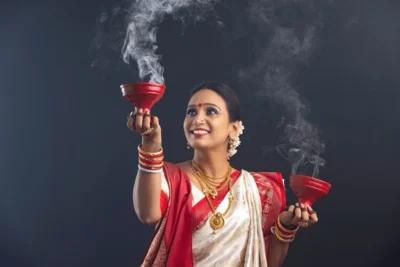
The Dhunuchi Naach finds its origin in the entire mythological and ritualistic background of Durga Puja. As per Hindu mythology, for nine nights, Goddess Durga fought a fierce battle with demon Mahishasura and killed him on the tenth day, namely, Vijaya Dashami (Bijoya Dashami in bengali). During this time, believing that the goddess needed strength and encouragement, her devotees filled dhunuchis with herbs and aromatic woods and kept fuming to strengthen her spirit. What might have then begun with solemn prayers transformed very soon into a rhythmic and physical expression of prayer giving birth to what we now call Dhunuchi Naach.
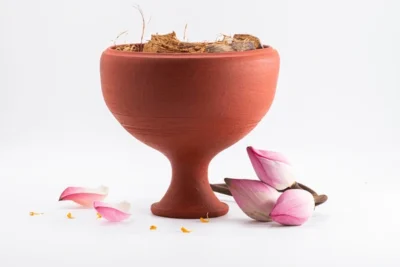
The dhunuchi itself has rustic origins and was traditionally fashioned in terracotta or brass. Such a brass incense burner, quite common in homes all around Bengal, was also used for fumigation with incense and camphor smoke in various rooms-all for the sake of clearing negative energies from the sacred space. Slowly, ceremonial values were ascribed to their use during the period of Durga worship. Records suggest that the dance had already spread to household pujas dating as far back as the 1700s, especially among zamindar families in Bengal, where priests and family members would perform it during evening aartis. They were not the ostentatious versions we see nowadays-they were small acts of devotion, simple and sincere.
The Hinduism ritualistic principle of using fire and smoke adds connotations to the origin of this dance. Smoke is thought to provide purification, eradicating negative energies and sanctifying a space for divinity. So, in a way, dancing with smoke became prayer, as well as a corporeal act of spiritual cleansing. The dancer is, therefore, an extension of the offering.
How It Flourished
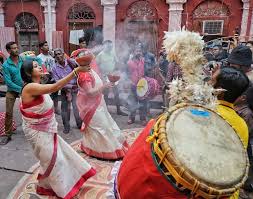
Dhunuchi Naach, similar to Durga Puja itself, has witnessed considerable change due to modernity in Bengal. While initially largely confined to courtyards and temple precincts, the growth of community pujas (sarbajanin puja in Bengali) from the 20th century brought this dance into a public arena. On the lines of democratization of the festival, where pujas were no longer elite affairs but collective community functions, the dance too was made participatory and free for all.
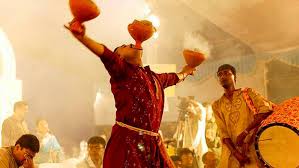
After Independence, urban clubs and cultural organisations started conducting Dhunuchi dance competitions, especially on the evenings of Maha Ashtami and Navami. These started to encourage creativity and endurance. Gradually, the dancers began to introduce more-complex-moves that demanded practice, including spinning, synchronizing with large groups, or dancing with two or even three dhunuchis—sometimes with one held between the teeth. The dance drew more attention as it became more ostentatious in public display of worship.
It is also important to note that the constructs around Dhunuchi Naach and gender have undergone changes over time. In early times, this was very much ritual performed primarily and dominantly by men only. But in the last few decades, the space has been redefined by women—their immaculate white sarees trimmed in red, temple designs on their foreheads with sindoor. The grace and rhythm brought in by women in the dance added another dimension, and nowadays, many famous performers are women.
Significance & Symbolism
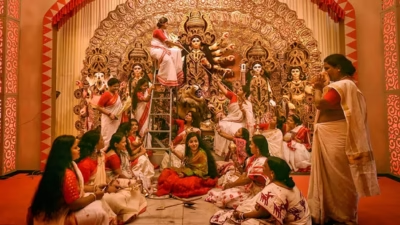
While it is an aerial spectacle, Dhunuchi Naach expresses lots of spirituality. The rising aromatic smoke is supposed to purify the atmosphere and uplift the collective spirit of the devotees. Scholars elucidate that the act of burning draws attention to the transformation of the material into the spiritual—a bodily manifestation of the spirit that raises the energy of both the performers and the watchers.
The dance is a celebration of victory over evil—Goddess Durga’s victory over Mahishasura. In this sense, the dance is an act of unifying the people, ripping the strength and unity for the Bengali culture. The dance itself is a spirit to watch as the music on which the dance is performed is also live. Primarily it uses two instruments one is the dhak and the other is the kashor ghonta which are used throughout the durga puja when sandhya arati and sandhi puja are performed. Both dhak and the kashor ghonta are rhythmic instruments with dhak being the dominant and lead instrument and the kashor ghonta is an accompanying instrument often played with the dhak. Both instruments when played together create a rhythmic as well as devotional ambience on the basis of which dhunuchi naach is performed.
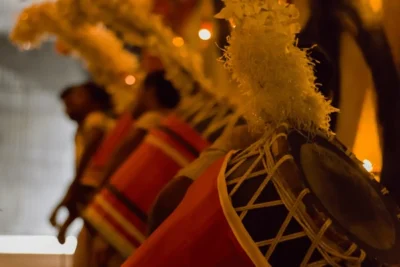
The Dance Itself & Current Practice
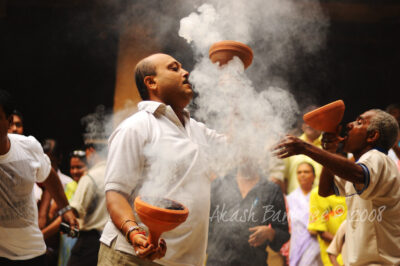
Lighted on the censers with coconut husk, incense, dried neem leaves, and camphor, the typical Dhunuchi performance opens. As the dhak begins to thunder, dancers enter the space-solo, and synchronized groups. The air gets thick with fragrant smoke swirling around the dancers, blessing them with an enveloping hug. They wave their arms outstretched and torsos swaying in rhythmic circles, their bodies stretched to become an extension of the flame and smoke before them.
While choreography is not really codified as in the classical dance forms, it is very expressive. It includes different types of movements such as spinning on your axis, shoulder rolls, hip sways, leg work, and footwork which matches that of the dhak. The fire and smoke from dhunuchi, however, have an immense value, not to mention the splendour that it brings in a visual sense; they feature as a medium for sacred connection between the human and the divine.
Today, Dhunuchi Naach performances are ubiquitous not necessarily in rituals but also in cultural events, stage shows, and even Durga Puja fashion shows as symbols of being rooted in traditions.
Conclusion
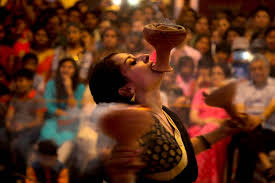
It is a ritual dance that forms a celebration of creation, mythology, faith, art, and society in itself and thus arguments for having such a legacy in living heritage of Bengal. Right from its fiery entry through the legend of Mahishasura to its competitive term of display in pandals and its presence in viral social media posts today, the spirit of this dance does preserve the initial value of cleansing, victory, and collective devotion.
Whether it is echoed through the powerful tempo of the dhak, or by seeing a dancer with three flaming incense burners atop his head, Dhunuchi Naach is a life-transforming experience. It compels performer and audience alike to share in a moment of transcendence-a sanctuary of smoke, sound, and sacred energy.
So the next Dhunuchi performance at Durga Puja may find you accompanying all that it represents: ancestral rhythm, faith communal pulse, celebration, and the still burning flame of a hosted tradition dancing vibrantly today.
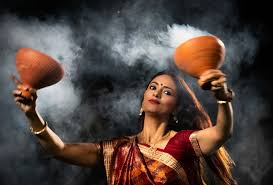
Bibliography
1.Dhunuchi Dance: The Origin and Significance of Bengali Durga Pujo ritual
2.The History of Dhunuchi Naach And The Bengali Durga Pujo Traditions
3.Dhunuchi, dhaak and the shonkho
4.What is Dhunuchi Naach? Why This Unique Dance Form is Performed in The Divine Presence of Maa Durga
5.Fire, Earth & Incense: All You Need To Know About Bengal’s Ancient ‘Dhunuchi Naach’




